
WorkSpace Week 2024
WorkSpace Health is EveryBODY’s Business! The Australian Chiropractors Association’s National WorkSpace Week (21-27 October) aims to reduce work-related musculoskeletal disorders (WMSDs) and improve the wellbeing of Australian workers by addressing modifiable risk factors and promoting early intervention.
WMSDs are the leading Work Health and Safety issue in Australia, responsible for 57% of workers’ compensation claims and costing the economy over $55 billion annually in health expenses, lost productivity, and reduced quality of life.
Launched by the ACA in 2022, this award-winning initiative takes place during National Safe Work Month and aligns with Safe Work Australia’s ‘WHS Strategy 2023–2033’ to create safer work environments. WorkSpace Week focuses on preventing WMSDs caused by physical and mental stress, repetitive work, and non-ergonomic workspaces.
Physical stress from improper lifting, pushing, or bending, poor posture, and repetitive strain can lead to chronic pain and other musculoskeletal issues. Mental stress in the workspace can trigger conditions like tension and cervicogenic headaches, affecting productivity and wellbeing. Early diagnosis and treatment can prevent long-term consequences, including chronic pain and mental health issues.
Workers at highest risk include healthcare, aged care, childcare, NDIS workers, tradies, labourers, and machinery operators. Workplaces are encouraged to join the #StraightenUpAustralia Challenge using ACA’s Straighten Up app to promote simple exercises that improve spinal health and reduce WMSDs.
The ACA urges organisations, individuals and community members to adjust their thinking when it comes to workspace health by registering for national WorkSpace Week. Registration is FREE and participants can access a suite of resources developed to help reduce work-related musculoskeletal disorders.
About
In response to the surge in work-related musculoskeletal disorders (WMSDs) among employees transitioning to remote work during the pandemic, the ACA launched a new public health initiative – WorkSpace Week in August 2022.
The inaugural campaign, titled “Work Well From Anywhere,” was aimed at improving the spinal health of computer workers using non-ergonomic home workspaces during COVID-19. It was a highly successful campaign which raised significant awareness about the importance of posture and workspace ergonomics, and in 2023, was recognised as a significant public health initiative receiving the Bronze Golden Target Award for Outstanding Health Campaign.
In 2023, to align with Safe Work Australia’s National Work Health and Safety (WHS) Strategy 2023–2033, WorkSpace Week broadened its focus beyond traditional desk workers to enhance workplace health across key at-risk industries. These industries, identified by both Safe Work Australia and the ABS, included a wider range of employees impacted by WMSDs such as body stressing.
Conducted during National Safe Work Month, and launched on Labour Day, WorkSpace Week 2023 encouraged Australians to “Work Well Anywhere – as early intervention is the best protection”. The campaign secured support and participation by various organisations around Australia including Government regulators SafeWork NSW, SafeWork SA, WorkSafe Tasmania, Department of Premier and Cabinet Tasmania, Department of Defence, CommCare, Department of Planning Lands and Heritage WA and was presented to the NSW Legislative Council by Abigail Boyd MLC. Councils across every state and the Northern Territory have participated in WorkSpace Week as have professional associations and businesses.
In 2024 WorkSpace Week will continue to promote maintaining spinal health so all Australian workers can work well everywhere. With workers engaged in repetitive movements and prolonged standing reporting the highest incidence of back pain, WorkSpace Week will also target those involved in regular lifting, pulling, and standing activities, whether at home or in the workplace.
PAST & PRESENT WORKSPACE WEEK PARTICIPANTS
Government departments, agencies across Federal, State and Local Government: Department of Planning, Lands and Heritage (WA), Department of Premier and Cabinet Tasmania, Safework NSW, Safework SA, Tasmanian Government, WorkSafe Tasmania
Associations: Australian Institute of Office Professionals (AIOP), Local Government Association of Tasmania, Master Builders Tasmania, Master Plumbers SA, National Disability Australia, Australian Chamber of Commerce and Industry, Australian Council of State School Organisations, Australian HR Institute, Australian Marketing Institute, Australian Psychological Society, ECTARC early childhood services and training, The Australian Association of Psychologists Inc and The Australian Industry Group.
State and Federal Politicians across Australia including MPs, MLCs and Senators: Hon Peter Malinausklas MP (SA), Leanne Castley MLA Office (ACT), Dan Repacholi MP – Federal Member for Hunter, Angus Taylor MP – Federal Member for Hume, Mr Terry Young MP Hon Colin de Grussa MLC (WA), Aileen MacDonald MLC (NSW), Mike Gaffney MLC (TAS), Kelly Brady MLC (WA), Paul Mercurio MP (VIC), Nicole Lawder MLA (ACT), Dheran Young MLA (NT), Jenny Aitchison MP (NSW), Kathy Tracey MP (NSW), Liza Butler MP (NSW), Hon Madeleine Ogilvie MP (TAS), Jacqueline Marchant MP (NSW), Caitlyn Long MP (NSW), Catherine Hutchesson MP (SA), Vica Bayley MP (TAS), Simon Wood MP (TAS), Tim James MP (NSW), Melissa Abbott MP (NSW). Tasmanian Liberal Government Tasmania,
Councils across Australia including: Augusta Margaret River Shire (WA), Aurukun Shire Council (QLD), Bogan Shire Council (NSW), Brewarrina Shire Council (NSW), Cairns Regional Council (QLD), Circular Head Council (TAS), City of Albany (WA), City of Canterbury Bankstown (NSW), City of Melville (WA), City of Mitcham (SA), City of Parramatta (NSW), City of Swan (WA), City of Sydney (NSW), City of Wanneroo (WA), Cumberland Council (NSW), Devonport City Council (TAS), District Council of Lower Eyre Peninsula (SA), East Gippsland Shire Council (VIC), Frankston City Council (VIC), Hawkesbury City Council (NSW), Hunter’s Hill Council (NSW), Huon Valley Council (HUONVILLE, TAS), Indigo Shire Council (VIC), Kangaroo Island Council (SA), Kempsey Shire Council (NSW), Livingstone Shire Council (QLD), Manningham City Council (VIC), Mareeba Shire Council (QLD), Midwestern Regional Council (NSW), Mildura Rural City Council (VIC), Mitchell Shire Council (VIC), Narrabri Shire Council (NSW), Narrandera Shire Council (NSW), Northern Beaches Council (NSW), Penrith City Council (NSW), Pormpuraaw Aboriginal Shire Council (QLD), Port Augusta City Council (SA), Pyrenees Shire Council (VIC), Scenic Rim Regional Council (QLD), Shire of Boyup Brook (WA), Shire of Capel (WA), Shire of Chapman Valley (WA), Shire of Exmouth (WA), Shire of Harvey (WA), Shire of Kojonup (WA), Shire of Moora (WA), Shire of Wyalkatchem (WA), Snowy Monaro Regional Council (NSW), Snowy Valleys Council (NSW), South Burnett Regional Council (QLD), Southern Grampians Shire Council (VIC), Swan Hill Rural City Council (VIC), The Barossa Council (SA), The Hills Shire Council (NSW), Town of Mosman Park (WA), Wagga Wagga City Council (NSW), Wentworth Shire Council (NSW), Whitehorse City Council (VIC), Willoughby City Council (NSW), and Woollahra Municipal Council (NSW).
Community Registrations
WorkSpace health is everyBODY’s business! Adjust your thinking and join the many organisations participating in this important, award-winning, community health initiative – WorkSpace Week.
Held during Safe Work Month (October), WorkSpace Week aligns with Safe Work Australia’s ‘Australian Work Health and Safety (WHS) Strategy 2023–2033.’ It aims to create safe, healthy workspaces for everyone and lessen the long-term impact on workers, employers, and the economy by improving the spinal health and well-being of Australians vulnerable to work-related musculoskeletal disorders.
Your participation in this significant public health awareness campaign will help educate employers and workers on the importance of taking a proactive approach to injury prevention.
By working together, we’ll help prevent modifiable risk factors in Australian workspaces which lead to injuries across a broad range of industries and professions and minimise the impact injuries have on the spinal health of workers across Australia.
Register today and we’ll email you a link to download a range of free campaign resources.
Together we can help prevent workspace injuries and encourage early intervention to minimise the long-term impact work-related injuries have on the lives of millions of Australians so we can all work well everywhere.
ACA members can access all WSW resources by clicking here.
Factsheets
WorkSpace health is everyBODY’s business! A variety of factsheets have been developed to target the modifiable risk factors in Australian workplaces known for triggering work-related musculoskeletal disorders.

Ergonomic Checklist
Computer & Desktop Workers
Work-related musculoskeletal disorders are not limited to workers who do lifting, pulling, pushing or carrying. Computer use in non-ergonomic workspaces, poor posture and the lack of effective exercise programs to improve spinal health and stabilise core muscle groups can lead to work-related musculoskeletal disorders including back pain, neck pain, shoulder stiffness and headaches, among others.
Download the free Ergonomic Checklist today and learn how to maintain a healthy spine when working using computers at home, at work or anywhere.
Factsheet – Stress & MSDs
Stress is a natural response to challenging situations and can manifest physically.
Stress can affect various body systems including the neuro-musculoskeletal system which comprises of nerves, bones, muscles, joints, tendons, and ligaments, that play a critical role in movement, stability, and posture.
Download our free Stress & MSDs Factsheet to learn more about managing stress-related musculoskeletal disorders.
Factsheet – Back Pain
Don’t let back pain hold you back!
This comprehensive resource provides valuable insights into the impact and causes of back problems and how chiropractic healthcare can help alleviate low, mid, upper and non-specific back pain to help improve your quality of life.
Download our free Back Pain Factsheet to learn more about back pain and the benefits of chiropractic healthcare.
Factsheet – Headaches
Are headaches holding you back?
If you or someone you know are among the 7 million Australians who suffer from tension headaches or the 4.9 million who suffer from migraine causing lost social activity, concentration and work capacity; chiropractic healthcare can provide effective, drug-free pain relief to headache and migraine sufferers.
Download the free Headache Factsheet today to learn how to maintain a healthy spine and overall health and wellbeing while at work.
Factsheet – Lifting & Bending Well
If you need to lift and bend to perform your work, you must do it safely.
A wide range of professions and occupations require workers to lift and bend at regular intervals during their workday. Moving or lifting objects that are large, heavy, bulky, awkward or difficult to handle can put employees at risk of work-related musculoskeletal disorders. These disorders can occur suddenly or develop over time and include sprains, strains, fractures and soft-tissue injuries to the back, hips or shoulders.
Download the free Lifting/Bending Factsheet today and learn how to maintain a healthy spine when bending and lifting at work.
Factsheet – Sitting Well
If your work requires you to sit for extended periods of time, you must sit safely.
Sitting for long periods of time is common to a wide range of professions and occupations in Australia. A lack of physical activity in the workspace can cause a range of health problems including cardio-vascular disease, diabetes, mental health issues and musculoskeletal disorders that can lead to headaches and chronic neck, shoulder and back pain.
Download the free Sitting Factsheet today to learn how to maintain a healthy spine and overall health and wellbeing when sitting at work.
Factsheet – Standing Well
If your work requires you to stand to perform your work, you must stand safely.
A wide range of professions and occupations require workers to stand for prolonged periods of time. If you find yourself or a colleague in a job that involves continuous standing for over an hour without shifting, or lasting more than four hours per shift, it’s crucial to manage how to stand correctly. Neglecting these aspects could potentially lead to chronic conditions, including lower and middle back pain.
Download the free Standing Factsheet today and learn how to maintain a healthy spine and overall health and wellbeing when standing at work.
Stand Corrected – Stretching Poster
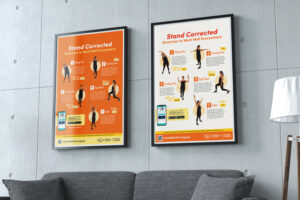 All-year-round workspace resource designed to promote safety and wellbeing.
All-year-round workspace resource designed to promote safety and wellbeing.
The Stand Corrected Poster assists your team’s wellbeing and productivity. By promoting a culture of safety and self-care, you’ll create a workspace where employees can thrive. Five simple stretches you and your team can perform regularly for a healthier, happier, and more efficient workspace.
Download one of the free Stand Corrected posters today and display in your workspace year-round.
– A2 Poster Light
–A3 Poster Light
–A2 Poster Orange
–A3 Poster Orange
Ergonomic Chair
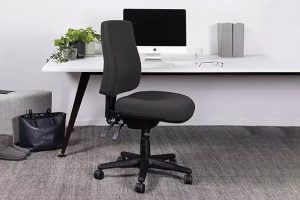 When working at a computer in an office or at home, it’s important to work using an ergonomic chair rather than just a normal chair. Unlike a normal chair, an ergonomic chair supports the spine, lower back, and pelvis and promotes good posture. An ergonomic chair also allows you to adjust the seat height, seat width, and depth.
When working at a computer in an office or at home, it’s important to work using an ergonomic chair rather than just a normal chair. Unlike a normal chair, an ergonomic chair supports the spine, lower back, and pelvis and promotes good posture. An ergonomic chair also allows you to adjust the seat height, seat width, and depth.
One of the most important elements of an ergonomic chair is that it offers lower back support through its lumbar adjustment. This lumbar adjustment is crucial to supporting the inward curve of the lower back. This is because sitting for long periods of time without proper support (for this section of your back) can not only lead to slouching – but also strains the vertebrae in the lower part of the spine3.
Your ergonomic office chair should allow you to have your elbows level (to the height of the work surface) with your shoulders and forearms relaxed when working at your computer or laptop.
If you cannot reach the floor, use a footrest for added support4.

Posture
 Adopting a safe and correct sitting position when working is vital to maintaining a good posture and a healthy back and spine. Sitting in incorrect positions can cause misuse or even overuse of specific muscles, ligaments, and tendons and can adversely impact your postural health5.
Adopting a safe and correct sitting position when working is vital to maintaining a good posture and a healthy back and spine. Sitting in incorrect positions can cause misuse or even overuse of specific muscles, ligaments, and tendons and can adversely impact your postural health5.
This is why it’s important to sit with an upright posture, with your shoulders relaxed and your feet flat on the floor.
It may feel good to slouch slightly as the day progresses, however, hunching can cause the muscles in your chest to contract and shorten, which contributes to not only a stiff neck- but a stiff back as well6.

Knee & Hip Position
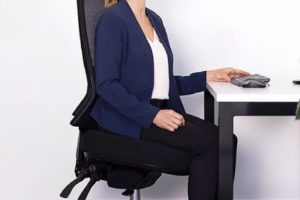 When you’re sitting at your desk, it’s important to adjust your chair so that it allows your knees to be slightly lower than your hips! This is because if you sit in a chair that’s too low, forcing your knees above your hip – that can place a lot of unwanted pressure, weight, and stress on your spine and the lower part of your pelvis7.
When you’re sitting at your desk, it’s important to adjust your chair so that it allows your knees to be slightly lower than your hips! This is because if you sit in a chair that’s too low, forcing your knees above your hip – that can place a lot of unwanted pressure, weight, and stress on your spine and the lower part of your pelvis7.
Similarly, a chair that is adjusted too high can lead to increased pressure on your knees and decreased blood circulation8, 9.
So while working throughout the day, take a moment to check your knees and hips are positioned correctly.

Computer Set Up
 No matter what location you work from, an office, at home, or in any other location, it is important to adjust your monitor or laptop screen to the correct height to avoid placing unwanted strain on your neck. If you tilt your head too far up or too far down, this can place a lot of extra stress on your neck and result in neck pain over time. Your monitor (or laptop screen) should be placed directly in front of you. If you have two monitors, position yourself between them whilst working.
No matter what location you work from, an office, at home, or in any other location, it is important to adjust your monitor or laptop screen to the correct height to avoid placing unwanted strain on your neck. If you tilt your head too far up or too far down, this can place a lot of extra stress on your neck and result in neck pain over time. Your monitor (or laptop screen) should be placed directly in front of you. If you have two monitors, position yourself between them whilst working.
The most important point to remember is to have your monitor height (or laptop screen) at eye level and approximately one arm’s length away from you10. If you need to adjust your monitor or laptop height you can use any solid object, with a wide enough base to prop up your laptop. So, get creative! You can even have several books piled up on top of each other.
When you are working, your keyboard and mouse should be on the same level, also directly in front of you, and positioned at least 10 to 15cms away from the edge of the work surface – to allow for good forearm support when operating the computer or laptop.
You also want to place your mouse parallel to your keyboard, with your elbows bent at around 90 –100 degrees. Also, try to keep both your arms close to your body to avoid unnecessary neck and shoulder pain.11

Standing
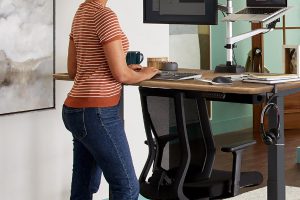 Standing desks offer a flexible and healthy alternative to the traditional sitting all-day desk setup. Standing desks also allow you the opportunity to alternate between sitting and standing throughout the day12. There are two common types of sit-to-stand workstations, the first being a whole desk unit that is manually, or power-operated to adjust to the preferred height.
Standing desks offer a flexible and healthy alternative to the traditional sitting all-day desk setup. Standing desks also allow you the opportunity to alternate between sitting and standing throughout the day12. There are two common types of sit-to-stand workstations, the first being a whole desk unit that is manually, or power-operated to adjust to the preferred height.
The second option is a modular type of desktop unit that sits on top of one’s desk and is usually adjusted manually or with a set of lever locks. Although you can purchase custom-built standing desks, you can also convert a regular desk into a standing desk at no cost by elevating your computer.
Not only does the stand-up desk mitigate extended periods of sedentary sitting, but it also increases metabolic function, decreases blood pressure, and provides lower back pain relief13. Not to mention, a stand-up desk also provides greater musculoskeletal comfort14. Finally, standing desks have also been shown to improve productivity and mental focus – so get standing!

Breaks & Stretching
 Sitting for long periods of time can be harmful to your spinal health, so make a conscious effort to take breaks by scheduling in mini-breaks every 30 minutes to keep your body moving throughout the day.
Sitting for long periods of time can be harmful to your spinal health, so make a conscious effort to take breaks by scheduling in mini-breaks every 30 minutes to keep your body moving throughout the day.
Taking regular breaks allows you to reset, recharge and refresh! Sitting for hours a day places a lot of stress on the natural curvature of the spine. So, if your back starts to feel tight and uncomfortable from sitting, completing a few stretches will help to relieve any build-up of pressure and tension on the spine. Stretching also promotes increased blood circulation and acts as a great form of stress release.

Consult a Chiro Podcast
 The Consult a Chiro Podcast is dedicated to providing valuable health and wellness information. Gain insights from experts, explore the latest research, and uncover practical tips for improving your health and wellbeing.
The Consult a Chiro Podcast is dedicated to providing valuable health and wellness information. Gain insights from experts, explore the latest research, and uncover practical tips for improving your health and wellbeing.
Learn about the benefits of chiropractic care and how chiropractors can be a valuable part of your healthcare team.
Listen to the Consult a Chiro podcast today.


Straighten Up App

While your chiropractor can’t be there 24/7 correcting your posture, the Straighten Up app can! Designed to act as ‘Your Pocket Chiropractor’, this app aims to address the growing posture issues and back pain problems faced by Australians.
Some of the features of the app include setting reminders to receive notifications about sitting right, stretching, taking breaks and improving your posture. The app also includes a 3-minute exercise program designed to improve spinal health, stabilise core muscle groups and more. The app also shows a list of local ACA chiropractors to help you find a chiropractor near you.
Download the Straighten Up app today.



Straighten Up Challenge

WorkSpace health is everyBODY’s business. This National WorkSpace Week (21-27 October), businesses large and small are adjusting their thinking around workspace health and mobilising their staff to take part in the #StraightenUpAustralia challenge with the Straighten Up app designed to help minimise work-related musculoskeletal disorders and improve productivity and overall spinal health and wellbeing.
The Straighten Up app helps Australian workers reduce work-related musculoskeletal disorders through promoting regular stretching and short, regular breaks. It’s a fun, creative team-building exercise encouraging everyone to work well, everywhere, because WorkSpace health is everyBODY’s business!
If you’re looking for a fun and beneficial activity to conduct for National Safe Work Month join the #StraightenUpAustralia challenge to improve your workspace health.
Get your team moving with the #StraightenUpAustralia Challenge today. Make it fun, be energetic, get creative and be part of #StraightenUpAustralia during National WorkSpace Week!
- Download the ACA’s Straighten Up app: Perform one of the exercises from the app.
- Download the StraightenUp Australia Challenge poster to promote your challenge.
– SU Challenge Poster 1
– SU Challenge Poster 2
– SU Challenge Poster 3 - Share Your Challenge: Post a pic or video of you doing the challenge using the hashtag #StraightenUpAustralia #MyHealthyWorkspace and encourage others to join in!
Consult a Chiro
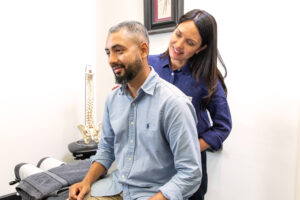 Early intervention is the best protection against work-related musculoskeletal disorders.
Early intervention is the best protection against work-related musculoskeletal disorders.
ACA chiropractors, Australia’s leaders in chiropractic healthcare, can help prevent work-related spinal health conditions caused by physical or mental stress.
ACA chiropractors can provide advice on how to prevent work-related back and neck injuries, how to set up an ergonomic workspace, improve posture and manage stress. They can tailor exercises to help improve spinal health and stabilise core muscle groups and provide lifestyle and dietary advice to promote overall health and wellbeing to help Australians work well anywhere.
But should workspace injuries occur, it’s important to seek early chiropractic healthcare to help prevent deterioration of an injury, improve recovery, reduce severity and prevent long-term implications including depression and overuse or reliance on medications for chronic pain that can be harmful.
To consult a chiro to help prevent workspace injuries or to treat work-related musculoskeletal disorders, find an ACA chiropractor near you.

For a full set of references, click here.
Media
23 October 2024: Women’s Workspace Pain Epidemic: WMSDs & Australian Women
21 October 2024: Media Release: Data Reveals Need to Rethink Workspaces to Combat Australia’s Leading Work-Related Injuries
2 October 2023: Media Release: New data reveals 87% of Australian adults have experienced a work-related musculoskeletal injury with prevention the best protection.
30 August 2023: Media Alert: WorkSpace Week warning for workers most at risk of spine-related injury
21 August 2022: Media Release: New data reveals health warning for Australians working from home
For interviews with Australian Chiropractors Association representatives and case studies, please contact Insight Communications.
Landline: 02 9518 4744
Clare Collins | 0414 821 957 | [email protected]
Alice Collins | 0414 686 091 | [email protected]

